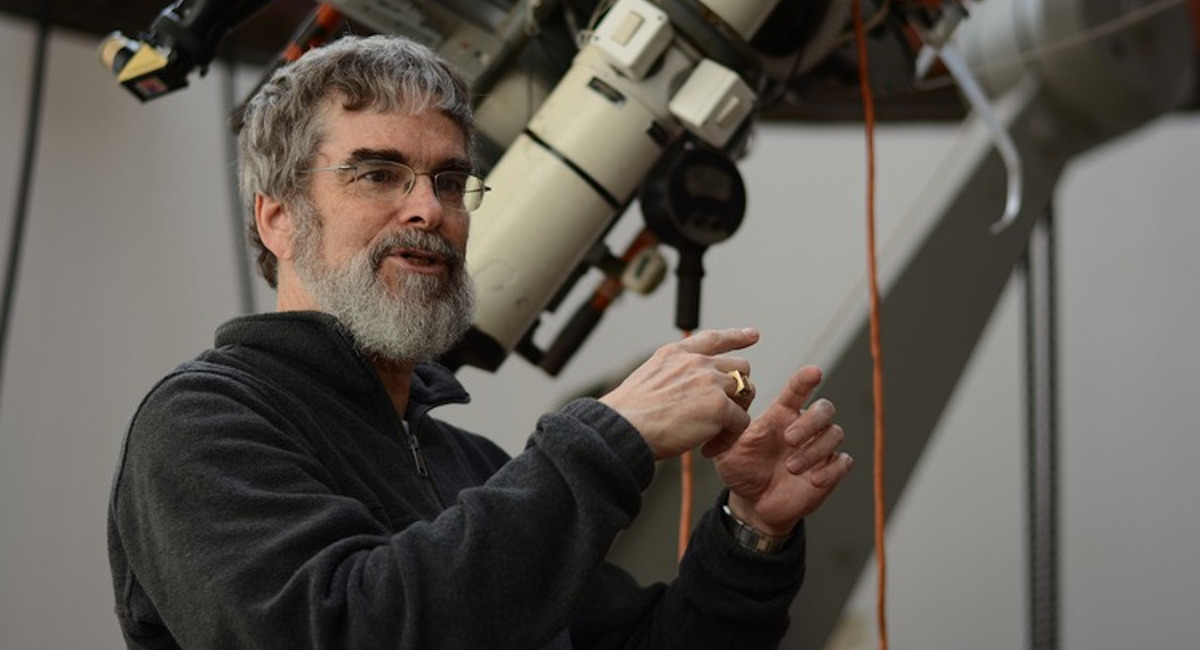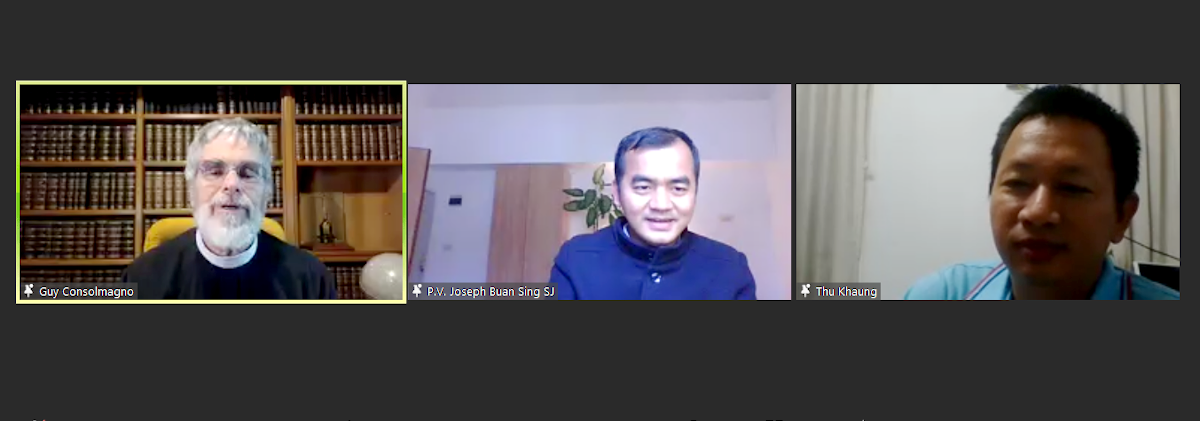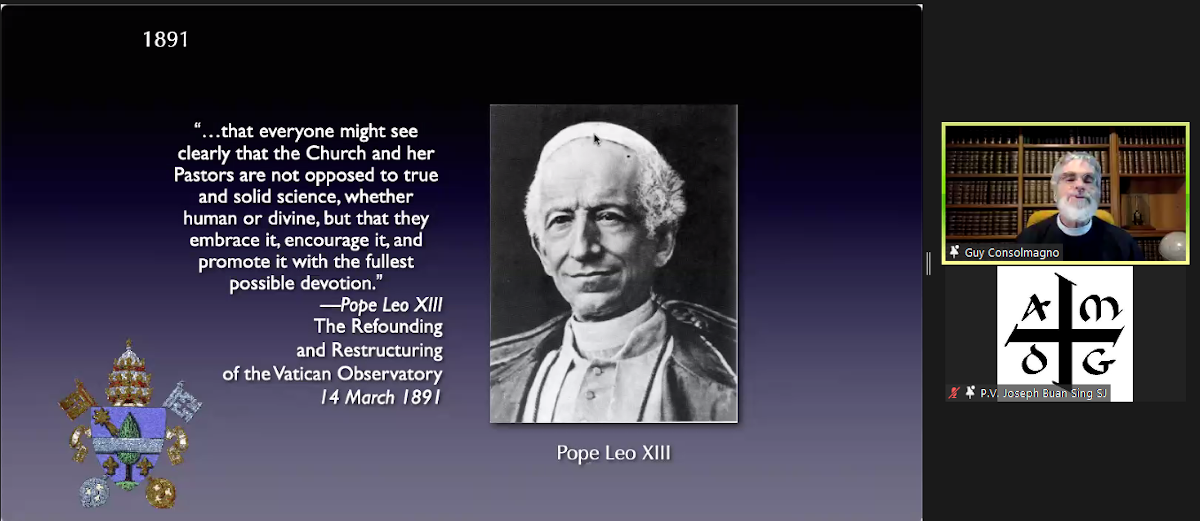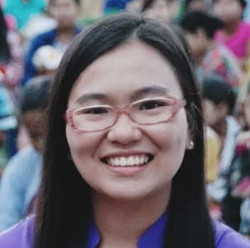
“How does a Jesuit scientist meet God?” This question paved the way for an engaging discussion between Br Guy J Consolmagno SJ, known as the Pope’s Astronomer, and over 100 young people from Myanmar, Singapore, Malaysia, the Philippines, Indonesia, Cambodia, Vietnam, Japan, India, and other parts of Asia.
The virtual session was organised by Magis Myanmar on 31 October to celebrate the Feast of St Alphonsus Rodríguez SJ, the patron of all Jesuit brothers, and porters. Br Guy, who is the Director and President of the Vatican Observatory and Foundation, shared his journey as a Jesuit scientist, and the Jesuits’ contribution to science, hoping that through his stories, young people will be led to find God in all things.
In the early 1980s when Br Guy was not yet a Jesuit, and working as a postdoctoral fellow and lecturer at the Harvard College Observatory, and then later at the Massachusetts Institute of Technology (MIT), he was confronted with the question, “Why do astronomy when there are people starving in the world?” This stirred something in him. He decided to leave MIT to join the US Peace Corps, where he served in Kenya essentially doing the same thing – teaching. The difference was the enthusiasm he witnessed from his high school friends and the curiosity of the people to know more about Saturn having glimpsed it through a small telescope.
“Their response was to go, ‘Oh! Wow!’” he said of the awe and wonder of his friends in Africa after seeing the rings of Saturn through his telescope. “That’s what human beings do when they encounter God’s creation,” he shared.
Br Guy contemplated on the desire of all humans to know more about the universe, about who we are, who made us, and our place in the universe. To deny people to ask those questions means denying them of an important aspect that makes them human. This turning point brought him to continue his work as a scientist, and then later, as a Jesuit scientist.
 He recalled in 1996 being part of a team that was deployed to Antarctica where meteorites are “easy to see and where they can stay frozen and untouched by the Earth’s atmosphere”. His search for these rocks brought him to a place of deep astonishment. He was standing on a frozen ocean. Since some of his earlier research was on the ice-covered moons of Saturn and Jupiter, this reminded him that our world is much bigger than just the planet Earth.
He recalled in 1996 being part of a team that was deployed to Antarctica where meteorites are “easy to see and where they can stay frozen and untouched by the Earth’s atmosphere”. His search for these rocks brought him to a place of deep astonishment. He was standing on a frozen ocean. Since some of his earlier research was on the ice-covered moons of Saturn and Jupiter, this reminded him that our world is much bigger than just the planet Earth.
“God created more than just what we see around us,” he shared. “I think Astronomy gives us a sense of a universe that is bigger than just myself, than what I am going to eat for lunch…. We are made to engage the universe and ask God: ‘Where do I fit into all of this?’ We are not made for and do not live by bread alone.”
St Ignatius of Loyola understood this very well, said Br Guy. In his autobiography, St Ignatius wrote: “The greatest consolation that he received at this time was from gazing at the sky and stars, and this he often did for quite a long time.” This sense of wonder, which gave Ignatius “a strong impulse to serve the Lord,” is integral in the spirituality of the Jesuits today. Many Jesuit scientists collaborate with the Church and different groups, in pursuit of a higher understanding of how objects or phenomena in the universe can help us grasp who God is in the things that have been created. The Jesuits’ most distinctive and remarkable work in science is to remind other scientists why we are doing it, said Br Guy.
For him, Jesuits are able to “do science that other scientists can’t do” because of the support of the Church. In fact the Vatican Observatory is an essential work of the Vatican. He expounds that most scientific projects are time-bound and results-oriented; hence, secular scientists are often pressured to meet the deadline set by their funders. But Jesuits, having the support of the Church and other groups, can pursue long-term projects that take more than a decade to explore.
 Since 2015, when Pope Francis appointed him as Director of the Vatican Observatory, Br Guy has been attending the Pope’s annual conferences. He recalled a time when he was seated at the back, “in the very last row in the far corner of the room, but I was in the room! That means that the Church supports the kind of work we do because it recognises the importance of showing the world how the Church supports science.” Br Guy’s work in Astrophysics has given him the opportunity to meet St Pope John Paul II, Pope Benedict XVI, and of course, Pope Francis, during their visit to the laboratory of the Vatican Observatory.
Since 2015, when Pope Francis appointed him as Director of the Vatican Observatory, Br Guy has been attending the Pope’s annual conferences. He recalled a time when he was seated at the back, “in the very last row in the far corner of the room, but I was in the room! That means that the Church supports the kind of work we do because it recognises the importance of showing the world how the Church supports science.” Br Guy’s work in Astrophysics has given him the opportunity to meet St Pope John Paul II, Pope Benedict XVI, and of course, Pope Francis, during their visit to the laboratory of the Vatican Observatory.
The Vatican’s meteorite collection located in Castel Gandolfo is one of the largest collections in the world. Showing some photos of their samples, Br Guy explained that his work involves studying the physical properties of rocks. These rocks and iron are what fall from outer space, and “there is nothing quite so thrilling to know that the blue sky overhead is not just a barrier separating us from the rest of the universe. It’s not a barrier at all. Materials come through the sky, reaching us all the time.”
Nant Ei Thu Thu from Myanmar reflected that, “Faith explains ‘why’ the universe came to be, while science explains ‘how’ things came to be.” Many of the participants were thankful to learn from Br Guy how faith inspires science, realising better how science and their faith do not contradict, but complement each other.
Br Joseph Thu Khaung SJ thanked Br Guy for the encouragement and inspiration he gave the Magis members through this talk. He affirmed how important the conversation was to many young people, especially in Myanmar, who are struggling with the Covid-19 pandemic and the ongoing political crisis.
In response, Br Guy smiled and said: “I think one of the great things about Astronomy is it puts our daily problems into perspective. It helps when things seem to be overwhelming to go outside and look at the stars. And to realise that those stars will be there tomorrow. That God will be with us tomorrow even if sometimes, it’s cloudy, and we can’t see.”
 Precious Kyrie P Undag taught English at St Aloysius Gonzaga Institute of Higher Studies in Taunggyi, Myanmar from 2016 to 2017 during her year as a Cardoner Volunteer, a service programme offered to graduates and faculty members of Ateneo de Davao University in the Philippines aimed at strengthening social spirituality and promoting holistic growth through interreligious and intercultural encounters. Magis is the Jesuits’ youth ministry that seeks to form and transform young people in the way of St Ignatius Loyola, which is marked by cura personalis (personal care), discernment, and magis (more).
Precious Kyrie P Undag taught English at St Aloysius Gonzaga Institute of Higher Studies in Taunggyi, Myanmar from 2016 to 2017 during her year as a Cardoner Volunteer, a service programme offered to graduates and faculty members of Ateneo de Davao University in the Philippines aimed at strengthening social spirituality and promoting holistic growth through interreligious and intercultural encounters. Magis is the Jesuits’ youth ministry that seeks to form and transform young people in the way of St Ignatius Loyola, which is marked by cura personalis (personal care), discernment, and magis (more).

